The River Wandle was known for its famous brown trout, and for being one of the hardest-working rivers in the world in Victorian times. This post is all about the history of the River Wandle.
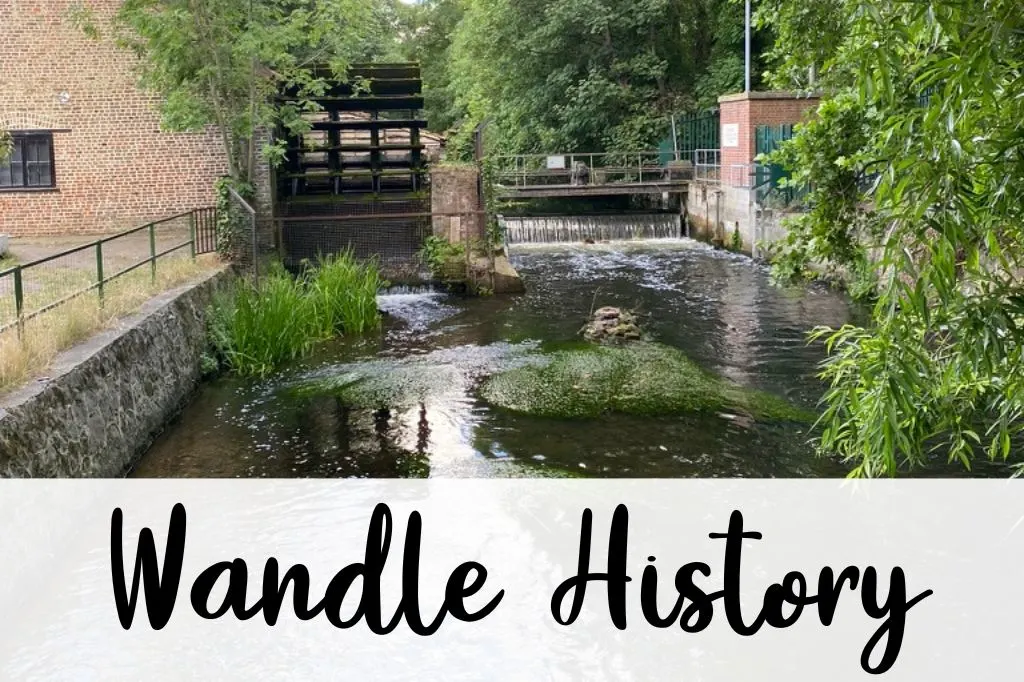
History of the River Wandle
The River Wandle at Different Times in History
Paleolithic and Mesolithic Periods
There is evidence of settlements around the River Wandle from as early as 4000BC. Signs of these settlements have been found in gravel in the lower Wandle, and in the Thanet beds between Croydon and Carshalton.
Neolithic Period, Bronze and Iron Age
Significant evidence has been found of weapons and fortifications from the Bronze and Iron ages. One of the most significant archeological finds by the River Wandle are the Waddon Caves. These caves may date from the Neolithic period, and provide evidence of settlement over the Iron Age, and Roman and Saxon periods.
The caves were discovered in June 1902, when a sewer was being built in the grounds of old Waddon House. The caves consisted of three beehive-shaped chambers that were dug into compact sand in the hillside. In October 1953 a fourth cave was found.
The caves attracted national interest. The newspaper clipping below is from the The Gloucestershire Echo on 05 Jun 1902.
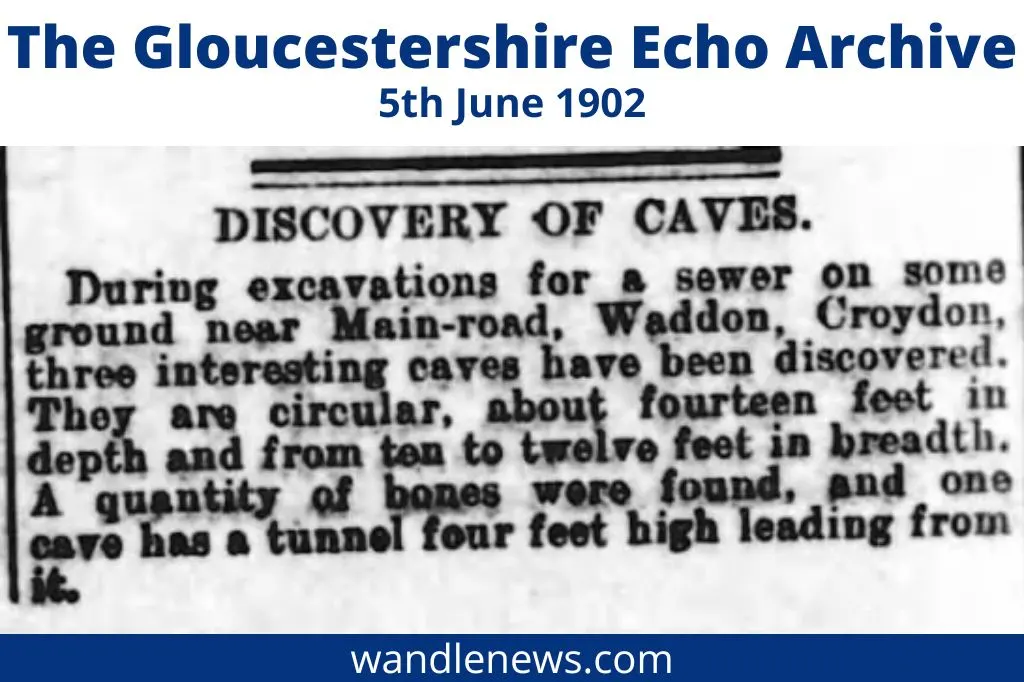
The following newspaper clipping was taken from the Birmingham Evening Despatch on 7th June 1902.
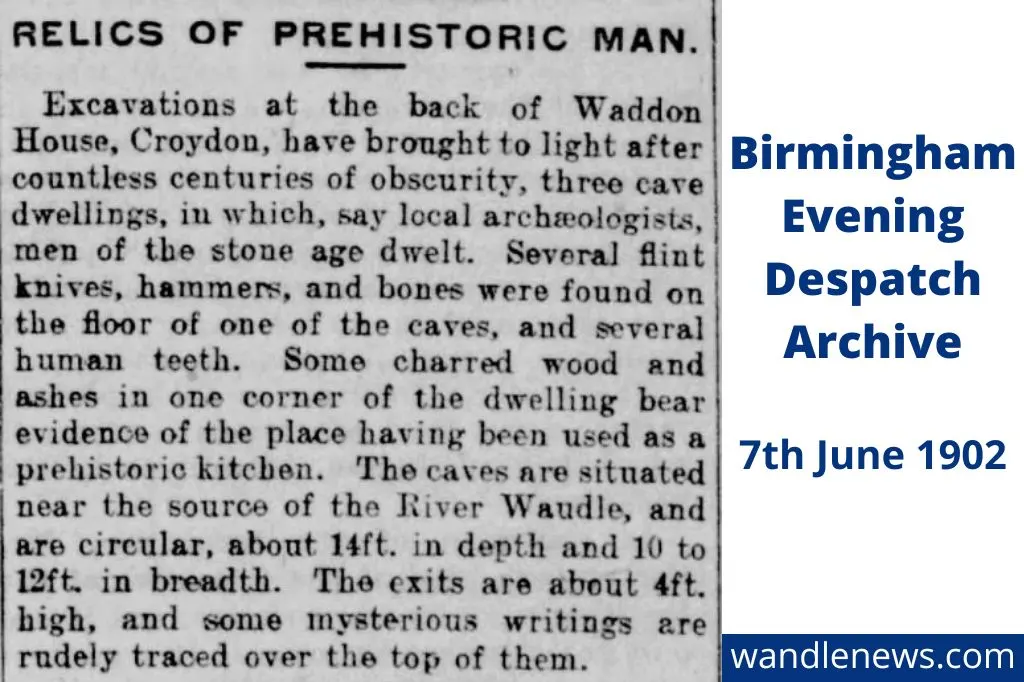
Roman Period
We have evidence that the Romans built settlements on several sites in near the River Wandle, particularly in Beddington where a bath house and burials are recorded. The remains of a small Roman villa were uncovered in Beddington in 1871 during the course of sewage irrigation works.
The river was well used during Roman times to support crops and livestock, as well as for washing. The Roman Road, Stane Street, which linked London (Londinium) to Chichester (Noviomagus Reginorum), crosses the Wandle Valley in Croydon and Merton.
Saxon Period
During the Saxon period many settlements were built by the River Wandle. Significant evidence of these settlements was found by the stretch of river from Croydon to Waddon, and Beddington to Wallington and Carshalton. A number of Anglo Saxon graves were also uncovered by the river in Mitcham.
At this time there were a number of springs and streams from Carshalton Ponds and around Wallington, which all flowed into the Wandle. No significant settlements were found between Merton and Wandsworth as this area is on lower ground and at risk of flooding.
It was during the Saxon period that the earliest reference to the River Wandle was found (in the year 693). The river was referred to as “hlida burnan” in the Wandsworth Charter (then called the Wendes Wurthe). Hilda burnan means “loud one” in Old English. It perhaps got its name due to the fast flowing, noisy stream.
Medieval Period
The Wandle was powering mills well before Medieval times, but by 1086, the mills on the river banks accounted for over half the total value of the manor of Wandsworth. The Domesday Survey records 13 mills in total on the banks of the Wandle, and at least 7 of them were owned by Westminster Abbey.
In 1114 Merton Priory, which was one of the most important religious buildings in England, was founded by the river.
During this time, the river Wandle was referred to as the “Lutborne” by monks at Westminster Abbey. The name “Lutborne” still derives from the Old English word meaning “loud one”.

Sixteenth Century
The earliest reference to the River Wandle being called its present name is in 1568. Through out the sixteenth century the river was referred to was “Wandal”, “Wandall”, or it’s Latinised name “Vandalis”. Its current name is taken from “Wandsworth”.
Seventeenth and Eighteenth Centuries
In the seventeenth and eighteenth centuries trout flourished in the River Wandle. The water was particularly favoured by brown trout who liked the fast flowing, clear streams.
Many famous anglers fished in the river Wandle at this time including Lord Nelson, British diplomat and volcanologist Sir William Hamilton, and the author of The Compleat Angler, Izaak Walton.
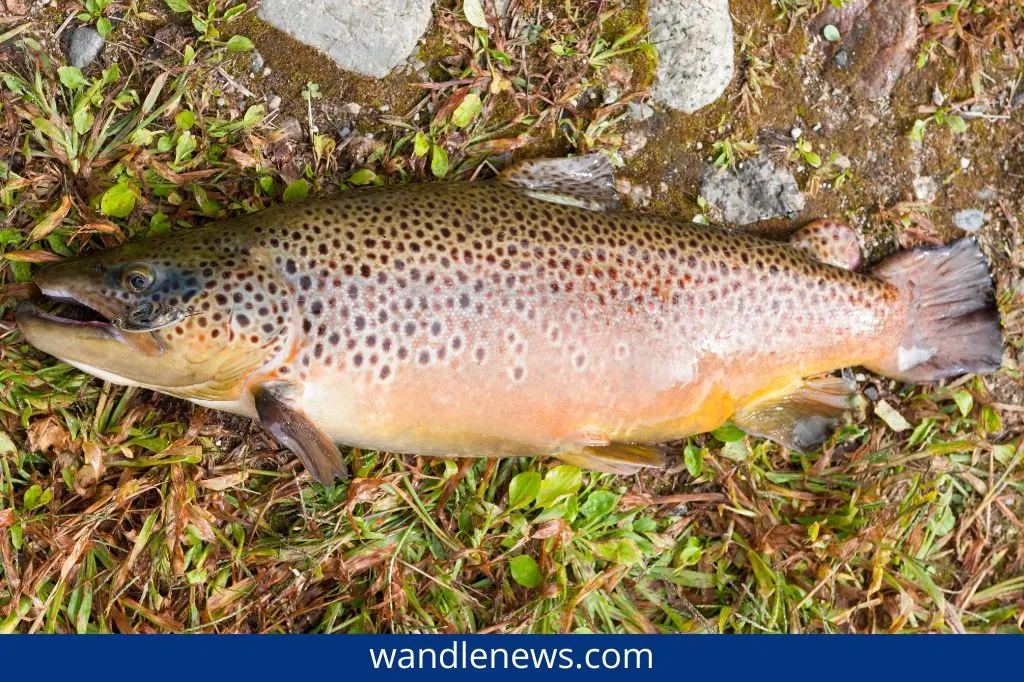
Nineteenth Century
By the start of the nineteenth century, the number of mills on the banks of the River Wandle had increased to 40. This included 12 calico works, 9 flour mills, 5 snuff mills, 5 oil mills, 3 bleaching grounds, 2 dye works, 1 paper mill, 1 skinning mill, 1 logwood mill and 1 copper mill.
The Surrey Iron Railway also opened in 1802 which linked Wandsworth, Croydon, Surrey and Mitcham. It meant that industries along the River Wandle could now easily transport goods to the River Thames.
As the power of water was overtaken by steam, factories along the river started producing paints, solvents and chemicals which eventually ended up in the water. Parts of the river turned into an open sewer, and by the end of the nineteenth century all the fish and wildlife in the River Wandle were dead.
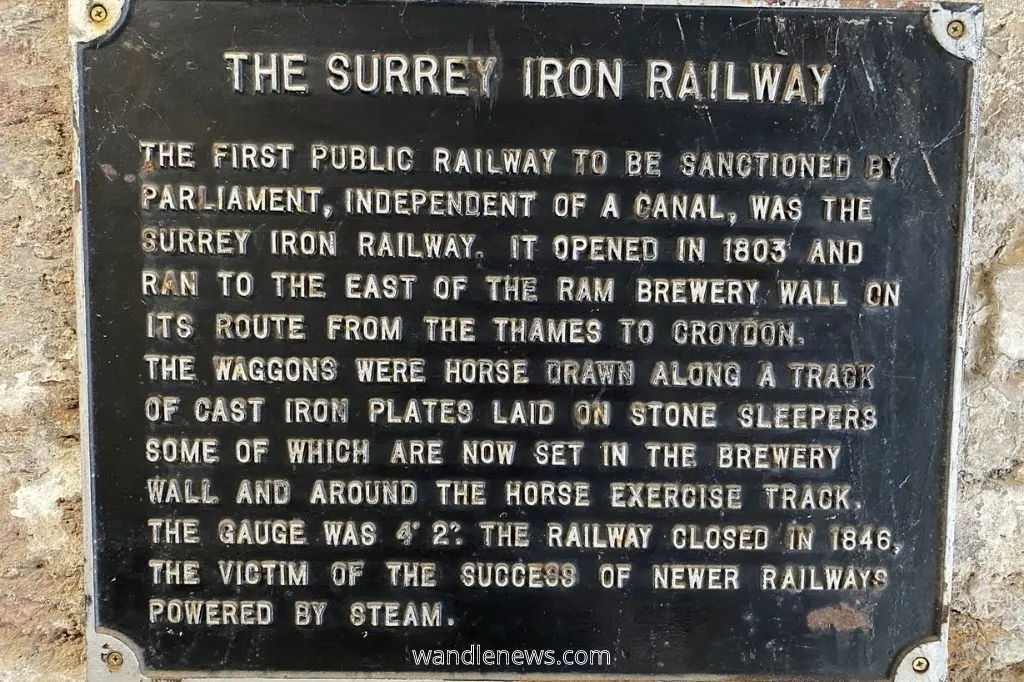
Twentieth Century
The pollution in the river Wandle continued to get worse. During the 1950s and 1960s the contamination of the river Wandle was at its worst.
The newspaper clipping below is from The Norwood News on 6th May 1960. It mentions all the industry along the River Wandle, and the wildlife that is now lost due to polltion.

The newspaper clipping below is from The Norwood News on 5th February 1960. It talks about the poor water quality which killed the wildlife of the River Wandle.
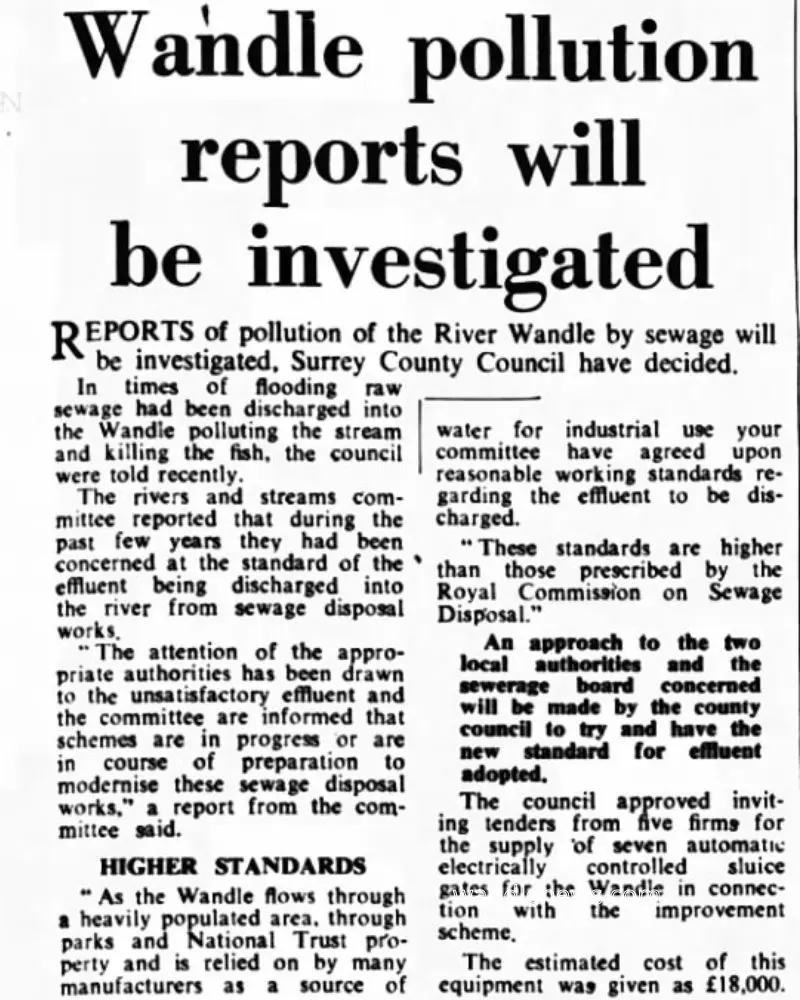
The newspaper clipping below is from The Norwood News on 27th December 1957. It refers to the Wandle as an open sewer.
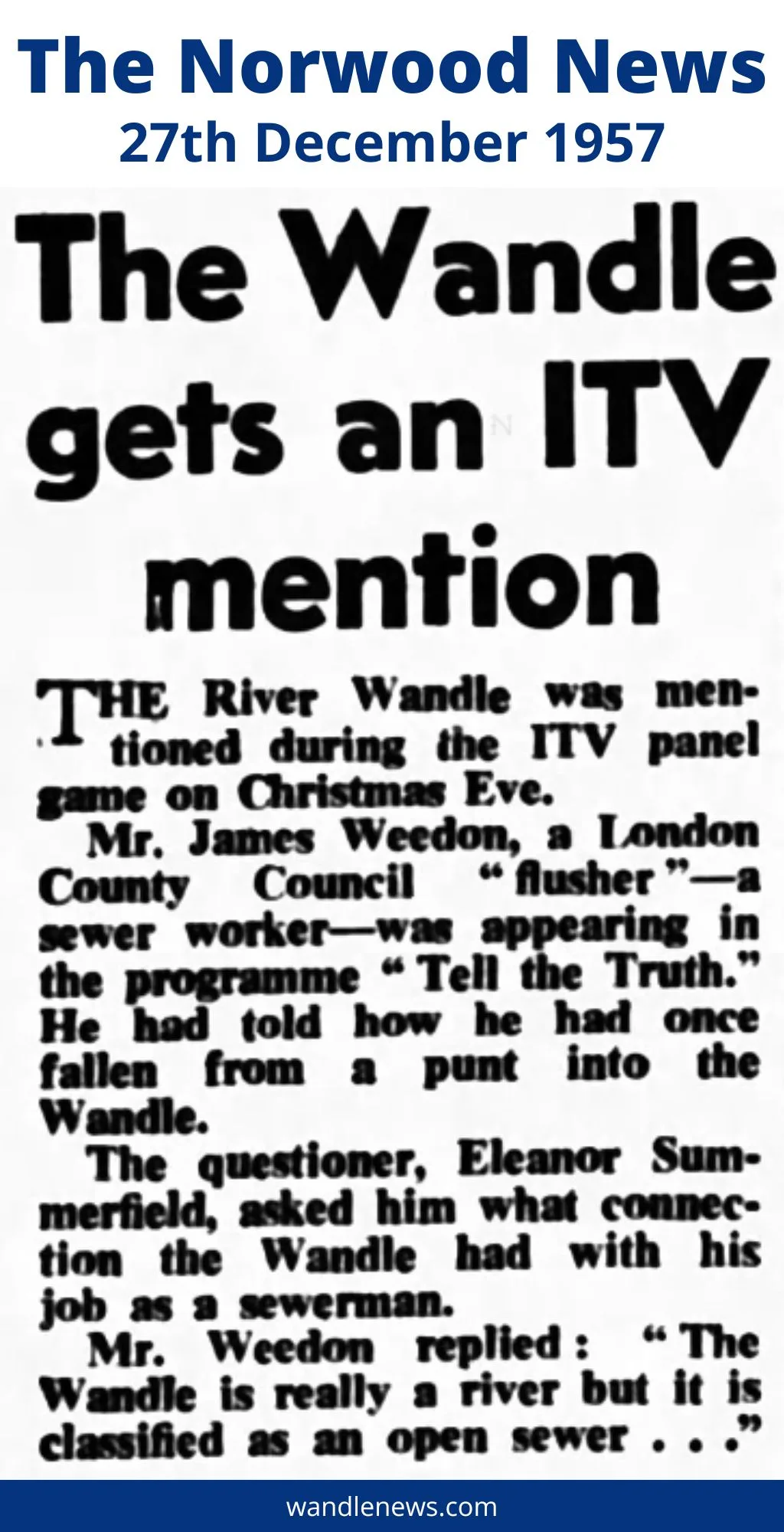
From the 1960s to Present Day
It was after the 1960s that the factories along the river closed down, and considerable effort was made to restore the river to its former state.
In 2011 the River Wandle won an award for being one of the most improved rivers in England and Wales. The water is once again clean enough to support fish of various species, as well as birds, and plants.
What was the River Wandle used for?
In history the River Wandle has had many uses including for washing, supporting livestock and crops, and powering water mills. The mills that once stood along the banks of the River Wandle included, calico and textile mills, snuff mills, paper mills, brewing mills, and dye and leather works.
The River Wandle was in an ideal location for manufacturing since it was so close to London where there was a great market for industrial goods. It also has a very steep gradient compared to other rivers which made it perfect for powering water mills.
Some sources suggest there may have been up to 90 mills along the banks of the River Wandle at one time, however local historian Peter McGow has only discovered 50 in his research.
Producing Calico and Other Textiles
The River Wandle attracted many cloth printing mills, particularly mills that printed calico (colourful printed cotton). It was the ideal location for the textile industry since the river is a chalk stream, with clear water for bleaching and dying material. The Wandle is also close to London where there were affluent customers who could afford to buy the expensive silks and fabrics.
Two of the most famous textile mills that once stood by the River Wandle were the mills of William Morris and Arthur Liberty. The mills once stood on the site that is today Merton Abbey Mills. The photograph below shows a millstone that was excavated at Merton Abbey Mills in 2004.
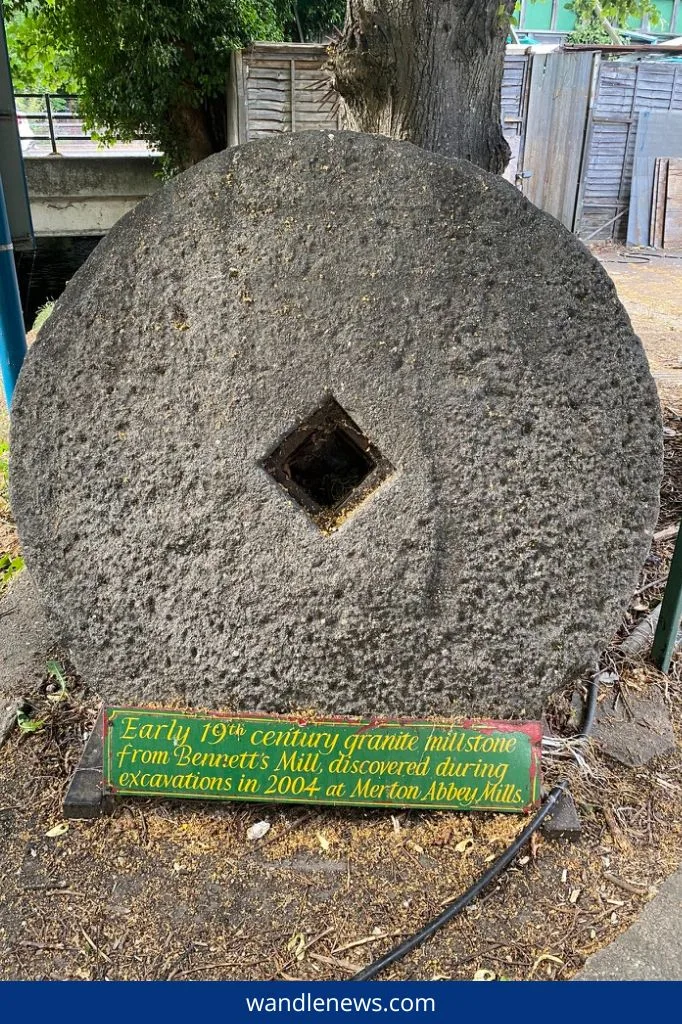
Producing Snuff
From the seventeen to the nineteenth centuries inhaling snuff was in fashion, and a number of mills existed along the Wandle to dry and grind tobacco. Today, the only evidence that still remains of the ovens used to dry the tobacco is at Ravensbury Mill where there is a bricked up arch in the wall.
Although there were many snuff mills along the Wandle, the majority of them were in Morden, between Ravensbury Mill and Morden Hall Park.
Leaving the village by the path across the marshes west of the church (Mitcham) the low rumble of a waterwheel betokens a mill at work and the fragrance shows that it is snuff.
Ogilvy 1914

Producing Paper
The earliest paper mill along the Wandle was owned by a Carshalton family called the Scawens. This mill along with an adjacent one made Carshalton a national centre for paper making in the late eighteenth century.
Before 1850, the major raw material for paper was old rags, which could easily be sourced from London. The paper mill in Carshalton was one of the first to use chlorine to bleach the rags.
In 1860 there are records of paper mills in Wandsworth which were far larger than those in Carshalton. In late Victorian times the Royal Paper Mills in Wandsworth supplied paper to The Times and the Illustrated London News.
Brewing
There were once many brewing mills on the banks of the Wandle, with Croydon having the largest number. The Crowley family acquired their Croydon brewery in 1808, and went onto own several other breweries in the country including the Alton Brewery and the Bell & Son, Itchen Brewery.
Another brewery once stood close to the river in Mitcham. The earliest reference we have of it, in 1789, refers to the Hughes Brewery, but it later became the Surrey Brewery and in 1884, the Eagle Brewery.
The largest and most successful of the Wandle breweries was the Ram Brewery. It was founded in 1831, and although it burnt down in 1882, it was rebuilt and went on to brew beer until 2006. The newspaper clipping below is from The Standard on 15th May 1882, and describes the fire that destroyed the brewery.
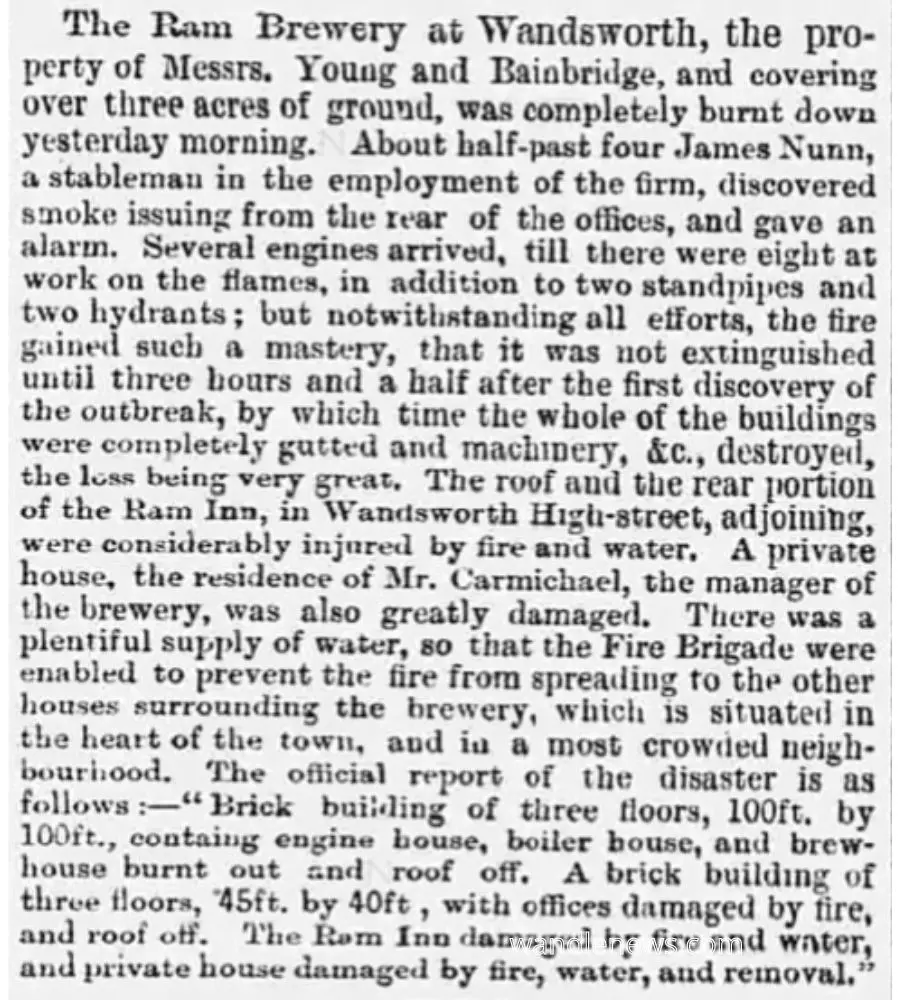
Dye Works
Dyeing was well represented along the River Wandle. Wandsworth became famous for producing scarlet dyes which were used by Catholic Cardinals for their hats. Some of the dyeworks along the river included the Madder Mill in Merton, and the seventeenth century logwood mill near Mitcham.
Leather Works
The earliest reference we have to a leather mill on the River Wandle, is at Goat Bridge in Carshalton in 1644. The site was associated with leather skins for nearly 300 years.
There were other leather working sites along the Wandle until well into the twentieth century. These included the Mitcham Mill in Carshalton, and the Eagle Leather Works in Carshalton which produced high quality soft leathers like buckskin.
One of the most famous leather mills on the River Wandle was Connolly’s Leather Mill in Merton. It had a reputation for producing high quality leather and specialised in producing leather for vehicles, particularly for Jaguar and Rolls Royce cars.
River Wandle Flooding History
Flooding of the River Wandle has been a problem ever since early settlers arrived in the Wandle Valley. There are records throughout history of the river banks being repaired and kept free from obstructions to prevent flooding.
Most of the times the River Wandle has flooded has been in the summer when there has been high rainfall intensity. An example of this happened in August 2022 when there was heavy rain following the heatwave, and the Environment Agency issued a flood warning for the River Wandle.
There were severe floods in 1968 all along the river, with Hackbridge being severely hit. Further flooding took place in 1977, 1982 and1985. Below are a selection of newspaper clippings from the 1950s and 1960s when the river was frequently flooding.


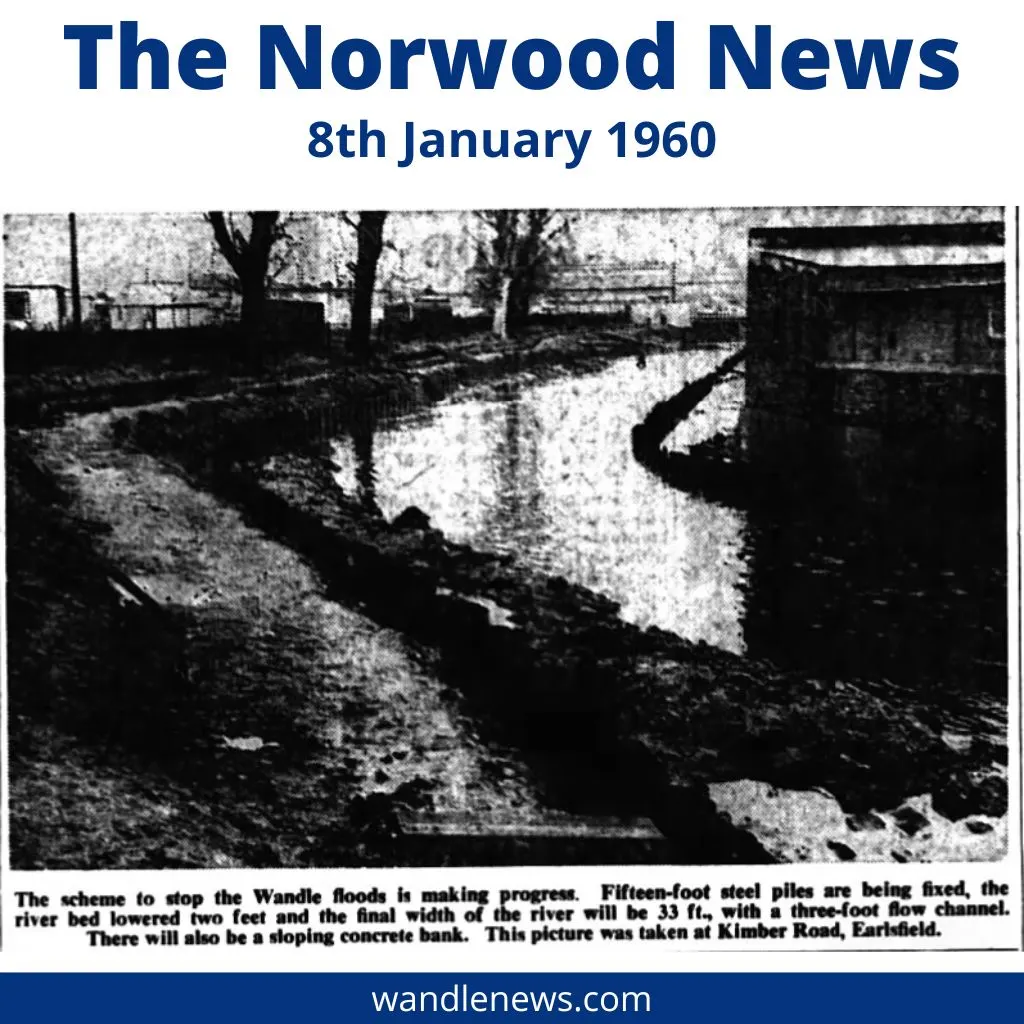

Useful Resources on the History of the River Wandle
I will update this webpage over time as I discover more information about the history of the River Wandle. If you are interested in the history of the Wandle Valley, I recommend the following useful resources.
- River Wandle Companion by Bob Steel and Derek Coleman – this is an excellent book with lots of information on the history of the area surrounding the River Wandle.
- Wandle Industrial Museum – the museum is located in Mitcham, Surrey.
- Merton Historical Society – the society organises monthly talks, and local historical guided walks.
- Merton Library – the Merton Heritage Service provides local history talks and exhibitions.
If you enjoy looking at historical photographs, why not check out this picture of a group of elephants in Carshalton Ponds from a travelling circus in 1901.
This Post was About the History of the River Wandle
Thank you for reading my post about the history of the River Wandle. If you have any suggestions, or want to contribute to the website, please get in touch!

hannah
Monday 16th of October 2023
Very helpful - thank you